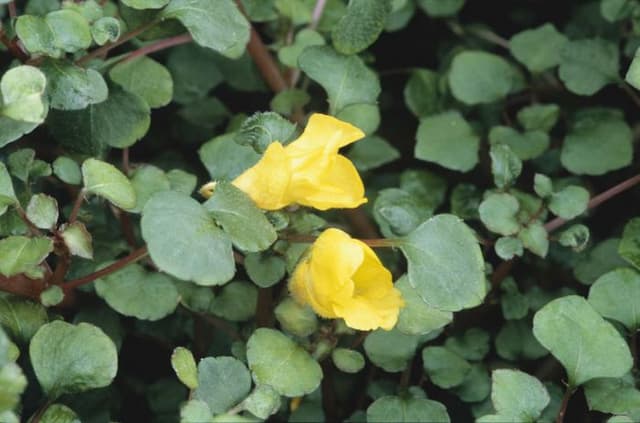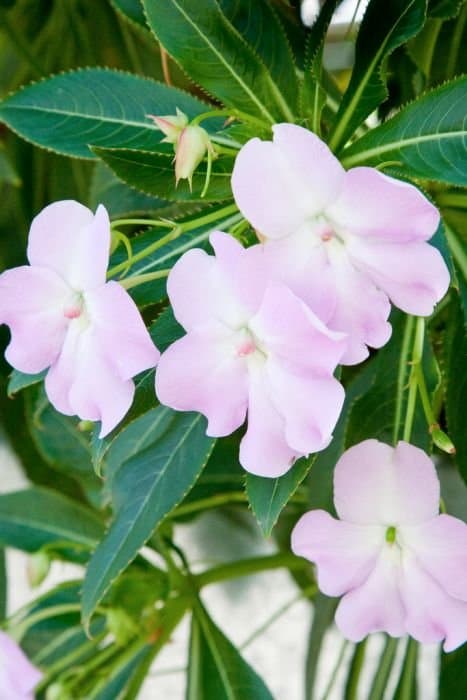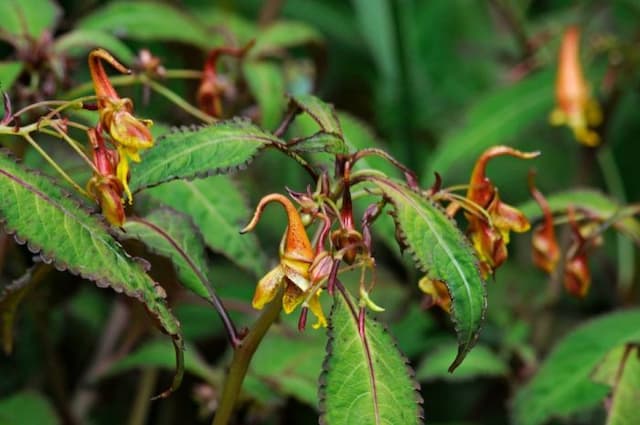SunPatiens Impatiens Sunpatiens Spreading Variegated Salmon = 'Sakimp005' (Sunpatiens Series) (Ng/v)
![busy lizzie [SunPatiens Spreading Variegated Salmon]](/_next/image?url=https%3A%2F%2Fplants-admin.emdemapps.com%2Fimages%2Fplants%2F%2Fimages%2F604b5caea5496.png&w=3840&q=75)
ABOUT
The Impatiens Sunpatiens Spreading Variegated Salmon is a vibrant and visually striking plant, notable for its appealing combination of colors and patterns. The leaves of this plant display a variegation pattern, combining shades of green with creamy white edges, creating a lively and textured foliage backdrop. Atop this attractive foliage come the flowers: they are a soft salmon pink hue, with a subtle gradation of color that can give them a lush, layered appearance. The blooms are sizable and prolific, covering the plant in a dense profusion that adds a non-stop display of color throughout the blooming season. The overall impression given by the Impatiens Sunpatiens Spreading Variegated Salmon is one of a robust and cheerful plant, with a spreading habit that makes it an excellent choice for adding a splash of enduring color to garden beds, borders or container displays. The contrast between the variegated leaves and the gentle salmon flowers makes this plant an eye-catching addition to any gardening space.
About this plant
 Names
NamesSynonyms
Sunpatiens, Variegated Spreading Sunpatiens, Spreading Variegated Impatiens, Variegated Sunpatiens Salmon.
Common names
Impatiens hawkeri 'SAKIMP005'
 Toxicity
ToxicityTo humans
Impatiens, commonly known as touch-me-not, is generally considered non-toxic to humans. Therefore, ingestion of Impatiens typically does not lead to poisoning or adverse health effects.
To pets
Impatiens, or touch-me-not, is not known to be toxic to pets. Ingesting parts of this plant usually does not result in poisoning symptoms or serious health issues in animals such as dogs and cats.
 Characteristics
CharacteristicsLife cycle
Annuals
Foliage type
Evergreen
Color of leaves
Variegated
Flower color
Salmon
Height
1-3 feet (30-91 cm)
Spread
2-3 feet (61-91 cm)
Plant type
Herb
Hardiness zones
10
Native area
Asia
Benefits
 General Benefits
General Benefits- Vibrant Color: Adds a splash of salmon pink color to gardens and landscapes with its variegated foliage.
- Extended Blooming: Typically has a long blooming season from spring through frost, providing consistent color.
- Sun Tolerance: Unlike traditional impatiens, it thrives in full sun conditions, making it versatile for garden placement.
- Disease Resistance: Resistant to many common garden diseases that affect impatiens, requiring less maintenance.
- Adaptable Growth: Capable of spreading and filling in spaces, making it ideal for ground cover or mass planting.
- Heat Tolerance: Performs well in hot climates where other impatiens varieties might struggle.
- Low Maintenance: Requires minimal care once established, making it suitable for all levels of gardeners.
 Medical Properties
Medical PropertiesThis plant is not used for medical purposes.
 Air-purifying Qualities
Air-purifying QualitiesThis plant is not specifically known for air purifying qualities.
 Other Uses
Other Uses- Container Gardening: Sunpatiens are excellent for adding vibrant color to pots and hanging baskets, where their variegated foliage and salmon flowers can create a focal point on patios or balconies.
- Landscape Accent: Due to their striking variegated leaves and bright flowers, Sunpatiens can be used to create an accent in a garden bed or along a border, drawing the eye and adding aesthetic appeal.
- Erosion Control: Because of their spreading habit, Sunpatiens can be planted on slopes or areas prone to erosion to help stabilize soil and prevent loss of topsoil.
- Photography: Their unique variegation and vibrant blooms make Sunpatiens a popular choice for garden photography, offering a stunning subject for both professional and amateur photographers.
- Seasonal Bedding: Sunpatiens can be used for seasonal bedding displays in public parks and gardens, offering long-lasting color from spring through frost in many areas.
- Butterfly Gardens: The nectar-rich blooms of Sunpatiens are attractive to butterflies, making them a great addition to butterfly gardens or nature-friendly landscapes.
- Theme Gardens: Sunpatiens can be incorporated into various themed gardens, such as a 'tropical' theme due to their lush appearance and vivid blooms.
- Live Events: Due to their showy nature, Sunpatiens can be used in plant displays at live events such as weddings or garden parties to create vibrant decor.
- Artistic Inspiration: The color and form of Sunpatiens can serve as inspiration for artists, be it for painting, drawing or any other form of art that takes inspiration from natural beauty.
- Craft Projects: The flowers and leaves of Sunpatiens can be used for craft projects, such as flower pressing, creating natural dyes, or potpourri.
Interesting Facts
 Feng Shui
Feng ShuiThe Impatiens is not used in Feng Shui practice.
 Zodiac Sign Compitability
Zodiac Sign CompitabilityThe Impatiens is not used in astrology practice.
 Plant Symbolism
Plant Symbolism- Patience: As the name "Impatiens" suggests, the plant is often associated with patience, reflecting the plant's resilience and ability to bloom under various conditions.
- Motherly Love: The nurturing and spreading nature of Sunpatiens is reminiscent of a mother's embrace, symbolizing care and affection.
- Enduring Affection: The long-lasting blooms of Sunpatiens can symbolize a steadfast and enduring relationship or emotion.
- Positive Energy: The bright salmon color can represent vitality, enthusiasm, and a positive outlook on life.
- Flexibility: The adaptability of Sunpatiens to different lighting conditions can signify flexibility and an ability to thrive in various environments.
 Water
WaterSunPatiens prefer consistent moisture and should be watered regularly, especially during hot weather. During high heat, water these plants deeply with about 1-2 gallons per week for garden-planted SunPatiens, ensuring the soil stays moist but not waterlogged. For potted SunPatiens, check the soil moisture daily and water when the top inch of soil feels dry, which may mean watering every couple of days. Reduce watering frequency during cooler, rainy periods, but never let the soil completely dry out. It's best to water them early in the morning to reduce evaporation and prevent fungal diseases that can be caused by nighttime watering.
 Light
LightSunPatiens thrive in bright, indirect light but can also handle direct sunlight, especially if acclimated gradually. They are best suited for locations that receive morning sunlight and partial shade in the afternoon to protect them from the intense heat of the day. The ideal spot is one where they get at least 4 to 6 hours of sunlight daily, ensuring vibrant blooming and healthy growth.
 Temperature
TemperatureSunPatiens are heat-tolerant and grow best in temperatures ranging from 60°F to 85°F. These plants can survive minimum temperatures of about 45°F, but frost and freezing temperatures will damage them. It's important to plant SunPatiens after the last spring frost and before the first fall frost. They perform optimally in summer when nighttime temperatures remain above 50°F.
 Pruning
PruningPruning SunPatiens is essential to encourage bushier growth and maintain plant shape. Trim off any leggy stems or spent flowers to promote new blooms and improve air circulation within the plant, which can reduce the risk of disease. Pruning is best done in the late winter or early spring before new growth starts, but light pruning can be done throughout the growing season as needed.
 Cleaning
CleaningAs needed
 Soil
SoilThe Impatiens SunPatiens prefer well-draining, fertile soil with a mixture of loam, peat, and perlite. The best pH range for this plant is slightly acidic to neutral, roughly between 6.0 and 7.0. A balanced soil mix promotes healthy growth and flowering of these vibrant plants.
 Repotting
RepottingImpatiens SunPatiens should be repotted annually or when the plant outgrows its current container. It is essential to provide fresh soil and a slightly larger pot to support the plant's growth and encourage vibrant flowering.
 Humidity & Misting
Humidity & MistingImpatiens SunPatiens thrive in moderate to high humidity levels. Aim for a relative humidity around 50-70% for optimal growth. If the air is too dry, the leaves may become crisp and lose their lush appearance.
 Suitable locations
Suitable locationsIndoor
Place Impatiens SunPatiens in bright, indirect light, away from drafts.
Outdoor
Place in partial shade, protect from strong winds, and water regularly.
Hardiness zone
10-11 USDA
 Life cycle
Life cycleThe life cycle of Impatiens Sunpatiens Spreading Variegated Salmon begins with germination, which occurs when the seeds are sown in warm, moist soil, usually in late winter or early spring under controlled greenhouse conditions. Seedlings emerge and the plant enters a rapid vegetative growth phase, where it develops its distinctive variegated foliage and robust, spreading habit. As temperatures increase, the plant initiates flowering, producing salmon-colored blooms that attract pollinators and may set seed if pollination occurs. Throughout the summer, the plant continues to flower and grow, often requiring regular watering and fertilization to maintain vigor. As the season progresses into fall and temperatures drop, growth slows, and the plant will eventually succumb to the first frost, completing its annual life cycle, unless it is grown in a perennial-friendly climate or overwintered indoors. If seeds have been produced, they may fall to the ground and go dormant, waiting to germinate the following spring, thus continuing the cycle.
 Propogation
PropogationPropogation time
Spring to Summer
Impatiens SunPatiens Spreading Variegated Salmon can be effectively propagated using stem cuttings. This is the most popular method for this plant. For best results, select healthy, non-flowering stems and cut a 4 to 6-inch (10 to 15 cm) section just below a leaf node. Remove leaves from the lower half of the cutting to prevent decay and place the stem in a moist, well-draining potting mix. Ensure the environment is warm, with high humidity, but not in direct sunlight. Roots typically develop within a few weeks, after which the new plants can be transplanted into individual pots or into the garden.
![Busy lizzie [SunPatiens Compact White Improved]](/_next/image?url=https%3A%2F%2Fplants-admin.emdemapps.com%2Fimages%2Fplants%2F%2Fimages%2F604b5dbdde5cf.png&w=640&q=75)
![Busy lizzie [Sun Harmony Deep Orange]](/_next/image?url=https%3A%2F%2Fplants-admin.emdemapps.com%2Fimages%2Fplants%2F%2Fimages%2F604b57b5f28cb.png&w=640&q=75)
![Busy lizzie [SunPatiens Compact Blush Pink]](/_next/image?url=https%3A%2F%2Fplants-admin.emdemapps.com%2Fimages%2Fplants%2F%2Fimages%2F604b64a6f0b6f.png&w=640&q=75)
![Busy lizzie [Divine Violet]](/_next/image?url=https%3A%2F%2Fplants-admin.emdemapps.com%2Fimages%2Fplants%2F%2Fimages%2F604b651b90e59.png&w=640&q=75)




![Busy lizzie [SunPatiens Compact Orange]](/_next/image?url=https%3A%2F%2Fplants-admin.emdemapps.com%2Fimages%2Fplants%2F%2Fimages%2F604b5ef883e70.png&w=640&q=75)
![Busy lizzie [SunPatiens Vigorous Magenta]](/_next/image?url=https%3A%2F%2Fplants-admin.emdemapps.com%2Fimages%2Fplants%2F%2Fimages%2F604b622adf631.png&w=640&q=75)